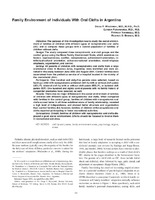Please use this identifier to cite or link to this item:
http://sgc.anlis.gob.ar/handle/123456789/230| DC Field | Value | Language |
|---|---|---|
| dc.contributor.author | Wyszynski, Diego F. | - |
| dc.contributor.author | Perandones, Claudia | - |
| dc.contributor.author | Yannibelli, Patricia | - |
| dc.contributor.author | Bennun, Ricardo D. | - |
| dc.date.accessioned | 2012-10-19T00:46:11Z | - |
| dc.date.available | 2012-10-19T00:46:11Z | - |
| dc.date.issued | 2005 | - |
| dc.identifier.issn | 1055-6656 | - |
| dc.identifier.uri | http://www.cpcjournal.org/doi/pdf/10.1597/03-118.1 | - |
| dc.identifier.uri | http://sgc.anlis.gob.ar/handle/123456789/230 | - |
| dc.description | Objective: The purpose of this investigation was to study the social environment of families of children with different types of nonsyndromic oral clefts (OC) and to compare these groups with a control population of families of children without clefts. Design: The study compared three nonsyndromic oral cleft groups and the control group using the Moos Family Environment Scale, which examines cohesion, expressiveness, conflict, independence, achievement-orientation, intellectual- cultural orientation, active-recreational orientation, moral-religious emphasis, organization, and control. Setting: All parents of children with nonsyndromic oral clefts from a large craniofacial clinic in Buenos Aires, Argentina, were identified and were enrolled in this study between June 2000 and August 2001. Control families were ascertained from the pediatrics service of a hospital located in the vicinity of the craniofacial clinic. Participants: One hundred and sixty-five parents were selected, based on having a child with nonsyndromic unilateral cleft lip with or without cleft palate (UCL/P), bilateral cleft lip with or without cleft palate (BCL/P), or isolated cleft palate (ICP). One hundred and eighty control parents with no family history of congenital anomalies were selected, as well. Results: There was no major difference in the social environment of families of children with different types of nonsyndromic oral clefts. When compared with families in the control group, families of children with nonsyndromic oral clefts scored better in all three subdimensions of family relationship, revealed a high level of independence, and showed better structure and organization than control families did; however, families of children with nonsyndromic oral clefts reported participating in fewer recreational activities. Conclusions: Overall, families of children with nonsyndromic oral clefts displayed a good social environment. Efforts should be focused to involve them in recreational activities. | en_US |
| dc.description | Fil: Wyszynski, Diego F. Boston University. Schools of Medicine and Public Health; Estados Unidos. | en_US |
| dc.description | Fil: Perandones, Caludia. ANLIS Dr.C.G.Malbrán. Centro Nacional de Genética Médica Dr. Eduardo Castilla; Argentina. | en_US |
| dc.description | Fil: Yannibelli, Patricia. Asociación Piel.; Argentina. | en_US |
| dc.description | Fil: Bennun, Ricardo D. Asociación Piel; Argentina. | en_US |
| dc.format | application/pdf | ES |
| dc.language.iso | eng | en_US |
| dc.rights | info:eu-repo/semantics/openAccess | en_US |
| dc.source | Cleft Palate-Craniofacial Journal, 2005, 42(2), 185–191. | en_US |
| dc.subject | Labio Leporino | en_US |
| dc.subject | Fisura del Paladar | en_US |
| dc.subject | Estrés Psicológico | en_US |
| dc.subject | Salud de la Familia | en_US |
| dc.title | Family environment of individuals with oral clefts in Argentina | en_US |
| dc.type | Artículo | es |
| dc.identifier.doi | https://doi.org/10.1597/03-118.1 | en |
| anlis.essnrd | 1 | es |
| item.cerifentitytype | Publications | - |
| item.fulltext | With Fulltext | - |
| item.languageiso639-1 | en | - |
| item.grantfulltext | open | - |
| item.openairetype | Artículo | - |
| item.openairecristype | http://purl.org/coar/resource_type/c_18cf | - |
| crisitem.author.dept | Administración Nacional de Laboratorios e Institutos de Salud “Dr. Carlos G. Malbrán” (ANLIS) | - |
| Appears in Collections: | snrd Publicaciones CeNaGeM | |
Files in This Item:
| File | Description | Size | Format | |
|---|---|---|---|---|
| CleftPalate-CraniofacialJournal,2005,42(2),185–191..pdf | 74.98 kB | Adobe PDF |  View/Open |
Page view(s)
277
checked on Dec 17, 2025
Download(s)
187
checked on Dec 17, 2025
Google ScholarTM
Check
Altmetric
Altmetric
Items in DSpace are protected by copyright, with all rights reserved, unless otherwise indicated.

